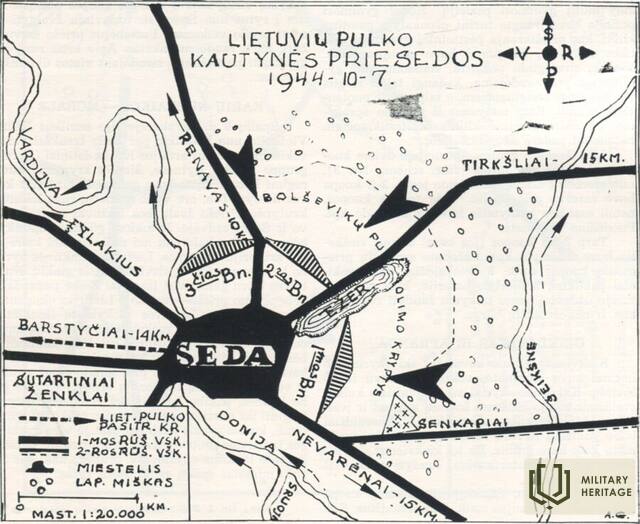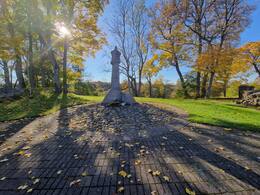Battle of Seda II World War II
The Battle of Seda took place on October 7, 1944, when units of the Lithuanian Homeland Security Team (TAR) tried to stop the Soviet Union army advancing westward. These battles were led by Col. H. Maederis, his adjutant was Capt. Štefanskis, and the staff officers were Lieutenants Kristas, Knoblochas, and Veleris. Capt. A. Kuzmickas was appointed as the communications officer.
The 1st Regiment of the TAR was commanded by Maj. A. Urbonas (his adjutant was Lt. Žukauskas), and the 2nd Regiment was commanded by Col. Mečys Kareiva (after his death, Lt. Col. M. Naujokas). The battalions were commanded by experienced officers: the commander of the 1st Battalion was Capt. Petras Puodžiūnas, and the commander of the 2nd Battalion was Capt. Pranas Počebutas.
On October 5, artillery fire was heard in the east. The volunteers, who were digging trenches in Barstyčiai at that time, were quickly recalled. The next day, October 6, by order of Col. H. Maeder, both battalions of the 1st Regiment marched to Seda and took up defensive positions. The 2nd Regiment, which was still in the formation stage, withdrew to Barstyčiai.
The headquarters of the 1st Regiment was established in an empty post office building. Permanent communication was maintained between the 1st Battalion and the headquarters by field telephones, and communication with the 2nd Battalion was maintained only by messengers. The Lithuanian positions were chosen in an unfavorable place - behind them flowed the Varduva River, over which a single bridge was built.
On the day of the battle, October 7, at around noon, several German tanks with several soldiers on each passed the Lithuanian positions in a westerly direction. The volunteers asked for tank support, but the tanks, having fired all their ammunition, moved towards Darbėnai, where their ammunition and fuel depot was located.
In each company of the 1st and 2nd battalions, soldiers were assigned who were to destroy the attacking tanks with "Panzerfausts". Their positions were set up about 200 meters on the enemy side from the main defense line. The first Russian T-34 tanks that appeared around noon were met with fire from "Panzerfausts" and "Panzershreks". The infantry accompanying the tanks were destroyed by mortars of the heavy weapons company led by Capt. P. Počebut and Lt. Bronius Nainys.
An interesting fact is that the Lithuanians had two Russian cannons, but they were not used effectively - a German shell got stuck in the barrel of one of them, and half of the crew servicing the cannon fled.
Among the participants in the battle was the writer Marius Katiliškis, who later became famous in exile, and whose dramatic testimony about the fighting has survived to this day. The indirect consequences of this battle also led to the death of the famous Lithuanian poet Vytautas Mačernis.
After the battle, on October 8, Order No. 193 of the Supreme Commander of the USSR was issued, which ordered the soldiers who had distinguished themselves for the capture of important German strongpoints (including Seda). On that occasion, a 20-gun salute was fired in Moscow at 10:30 p.m.
The Seda cemetery contains 96 mass graves of "liberators", each containing 6 dead, although historians note that not all of the soldiers buried there died in the Battle of Seda. The battle was the last organized attempt by Lithuanians to resist the Soviet occupiers in regular battle, after which some of the surviving soldiers joined the partisan movement.
More information sources
Related timeline
Related objects
Monument to those killed in the Battle of Seda
The monument to those who died in the Battle of Seda stands in the town of Seda itself, next to the Church of the Assumption of the Blessed Virgin Mary. This monument was unveiled on August 1, 1999. The author of the monument is sculptor Osvaldas Neniškis. The monument is dedicated to the memory of the soldiers of the Homeland Defense Team who died in the Battle of Seda on October 7, 1944.
The Battle of Seda was an armed clash between units of the Lithuanian Homeland Defense Forces and the Soviet Army that took place on October 7, 1944.
In the first half of 1944, the German occupation authorities in Lithuania abolished the Local Unit led by General Povilas Plechavičius, but as the situation at the front deteriorated, it had to take into account the Lithuanians' desire to create independent military units to fight the advancing Soviet army. In July, all Lithuanian combat units operating in Viekšniai parish and Mažeikiai county were merged into the so-called Homeland Protection Unit, which was subordinate to the German army. It was to defend the front line near Seda, as the USSR army advanced in the direction of Klaipėda.
As autumn approached, Seda was prepared for a circular defense: the majority of the Homeland Security Forces were deployed to the east and north of Seda, with one incomplete battalion near Barstyčiai, on the western side.
The units of the USSR army, which began the Klaipėda operation, reached the Seda area in early October 1944. On the morning of October 7, several dozen Soviet tanks attacked the approaches to Seda, defended by the Homeland Defense Team, followed by a rifle division. The battles for Seda were fought only in July, when about 6,000 volunteers, including 112 officers, 5 of whom had the rank of colonel, gathered into a military unit called the Homeland Defense Team.
The location of the battles is not marked, but you can visit the monument dedicated to those who died in the Battle of Seda.
Vytautas Mačernis Birthplace Trail
In the village of Šarnelė, Plungė district, in the birthplace of the Lithuanian poet Vytautas Mačernis, a path to the poet's birthplace has been established. Walking along this 545 m long path, you will reach the poet's grave. The poet died on October 7, 1944, during the Battle of Seda, when he was accidentally hit in the head by a fragment of an artillery shell. After his death, the poet's relatives returned the deceased back to Šarnelė to be buried in his homeland.
While walking along the V. Mačernis hiking trail, don't miss the nearby Kerpauskas spring and information stand. This spring commemorates an important historical period - the genocide of the Jewish people during World War II. The Kerpauskas spring is located by the path leading from the parking lot to the poet's grave. During World War II, the family of Juozas and Adolfina Kerpauskas hid Jews in underground bunkers installed at the foot of a small hill near the spring and in the homestead below. For three and a half years, the family took care of several Jewish families - 16 people in total - and protected them from destruction. During the Soviet era, Adolfina and Juozas Kerpauskas and their children Bronė and Tomas were deported to Siberia. Juozas Kerpauskas in 1992 and Adolfina Kerpauskienė in 2009 were awarded the Salvation Cross.
Related stories
The poet's last journey
On October 7, 1944, the same day as the Battle of Seda, the young poet Vytautas Mačernis was tragically killed while trying to escape to the West.
The last battles near Seda
On October 7, 1944, one of the last major battles of the regular army on Lithuanian territory took place near Seda, where volunteers of the Homeland Defense Team joined the fight against the Red Army, defending the freedom of Lithuania.
The Battle of Seda: A Story of Flight and Death
The 1944 battles near Seda experienced not only heroic moments, but also episodes of panicked running, when soldiers, seeing the impending threat of defeat, tried to save their lives.







